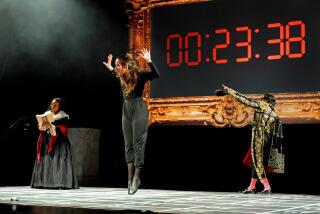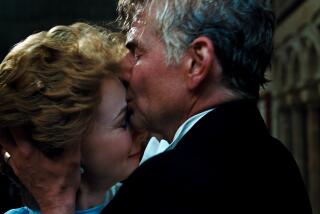MUSIC REVIEW : HORNE SINGS IN SUNDAY RECITAL AT AMBASSADOR
All evening long Marilyn Horne discreetly dabbed her brow with a handkerchief. Then, after nearly two hours of singing, she let the activity come to full attention, did a thorough dry-off and added a verbal caption: “Is it really 90 degrees today?” she laughed.
This little moment, so suavely brought off and perfectly timed, characterized the whole of Horne’s recital Sunday at Ambassador Auditorium. It was just one instance of the finesse that the mezzo-coloratura had at her command from beginning to end. Another came in the way she stepped back during ovations so that her superb accompanist, Martin Katz, could take a rare solo bow.
But the finesse extended beyond personal grace and sophistication as a performer. It also spoke of musical taste, restraint and intelligence.
From her first smooth step onstage, a step of supreme confidence that stopped short of haughtiness, Horne canceled any notion of diva posturings. She warmly acknowledged the cheering throngs that spilled beyond their regular seating areas without pressing for a fan-fest. What’s more, the singer, newly slim, looked positively fetching in her royal-blue gown with soft spangles.
The voice, not incidentally, was in top form. Horne always commanded a reliable instrument, its condition not nearly the issue so much as how she uses it. Sunday night she used it magnificently.
The coloratura virtuosa chose widely contrasting music--much of it from the 20th Century--that emphasized her versatility. Four songs from Mahler’s “Des Knaben Wunderhorn,” for instance, made a marked contrast with a Spanish group, as did a half-dozen Barber songs, given in honor of the late American composer’s birthday.
While her repertory choices let Horne shine as an artist (as opposed to a vocal acrobat) and offered a reprieve from those endurance contests she often weathers on the opera stage, she did offer a few choice samplings of Handel and Rossini. The latter’s “Canzonetta Spagnuola” (an encore) displayed with great dynamic and expressive subtlety her rippling roulades and chiseled trills; the former’s “Furibondo spira il venta” from “Partenope” sent out her flares of full-blown pyrotechnics.
But Horne shrewdly found a few other items that served her florid skills: a rip-snorting Bolero by Arditi and a religiously fervent song by Nin.
In the non-florid offerings she excelled as a dramatist. Each of the Mahler songs, for instance, conveyed different poetic intentions--her best being “Rheinlegendchen” where she captured both voices of this narrative with a lilting freedom. The Spanish items made a framework for her grandeur, despite a certain lack of timbral sensuality. She sang the wistful, ghostly, expansive songs of Barber simply and in clear, open voice.
What Horne can do now is make every gesture count. The precise moment a songs starts and finishes has its physical as well as vocal signal, one that invariably bears a specific meaning.
What she also did exceedingly well on this occasion was blend her distinctive chest tones with the upper registers. This proved particularly felicitous in Respighi’s well-known “Nebbie,” with its exposed descents.
More to Read
The biggest entertainment stories
Get our big stories about Hollywood, film, television, music, arts, culture and more right in your inbox as soon as they publish.
You may occasionally receive promotional content from the Los Angeles Times.










